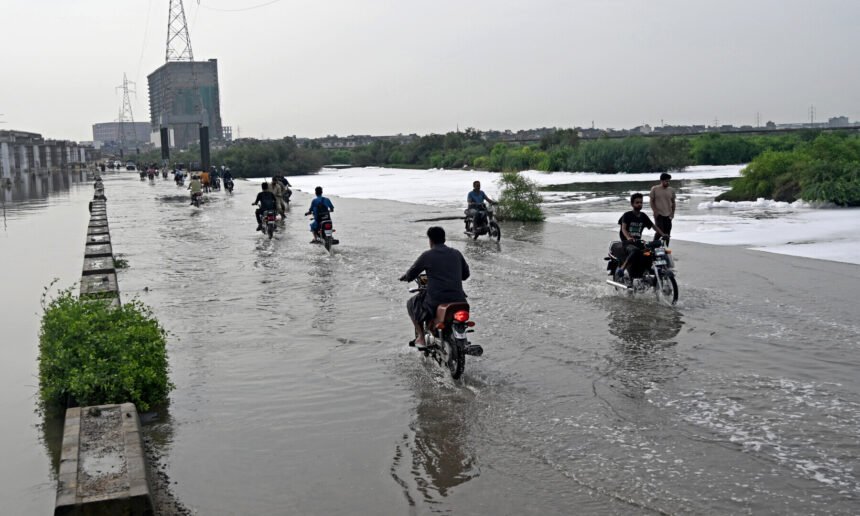National Disaster Management Authority’s (NDMA) Emergency Operations Centre said extremely heavy rainfall is expected over the next 12–24 hours in Karachi, Hyderabad, Thatta, Badin, Mirpurkhas, Sukkur and adjoining areas.
According to the statement, more than 50 to 100 millimetres of rain could fall in a short period. Owing to intense rainfall and inadequate drainage, the danger of urban flooding remains in Karachi, Hyderabad, Sukkur and Mirpurkhas.
In addition, flash floods are feared in Thatta, Badin, Jamshoro and Dadu districts, while rising water levels in the Indus River and its tributaries could trigger flooding in low-lying areas.
Second spell of rain hits Karachi on Wednesday as the city reeled from record monsoon downpours a day earlier that left at least 11 people dead, inundated neighbourhoods, disrupted power supply and damaged roads.
Karachi Mayor Murtaza Wahab on Wednesday said the city’s recent downpour was part of the wider challenge of climate change, which has also destroyed Khyber Pakhtunkhwa, Gilgit-Baltistan and Azad Kashmir in recent days.
Addressing a press conference, he said global warming and climate change were a reality and a test for administrations worldwide, citing the situations in New York, Dubai and Mumbai.
The mayor said the heavy rains left residents facing difficulties, with criticism and political point-scoring further exacerbating the situation. He noted that Karachi’s stormwater drains have a capacity of only 40mm. “When rainfall exceeds this amount, consequences become evident,” he said.
He posted on X, urging citizens to avoid Shaheed-e-Millat Road as clearing work was underway at the underpasses, and advised using Stadium Road or Shahrah-e-Quaideen as alternatives.
Traffic diversions also remained in place across the metropolis amid the lingering aftermath of the deluge.
PMD spokesperson Anjum Nazir Zaigham forecast that thunderstorms with rain could begin across Karachi within the next two hours.
He warned that due to expected rainfall today and tomorrow, there remained risks of urban flooding.
Rain relief efforts continued through the night and by Wednesday morning, Sharah-e-Faisal was mostly cleared, as was Shahrah-e-Bhutto. However, Korangi Crossing near Qayyumanbad remained flooded and closed from either side.
Vehicles were diverted from Qayyumabad Chowrangi towards Baloch Colony and from the CNG cut towards Godown Chowrangi, Express News reported.
The EBM Causeway Road near Mehmoodabad was also shut, with diversions set from Mehmoodabad towards the Expressway and from Godam Chowrangi towards Qayyumabad and Shan Chowrangi.
On Sharae Faisal, the track from the airport remained closed because of deep potholes and accumulated water, forcing traffic diversions from Star Gate.
Tariq Road underpass on Shahrah-e-Millat and Drigh Road Underpass towards the airport were also shut, with vehicles redirected to the service lane.
In Nazimabad, multiple underpasses — including Nazimabad No 1, Nazimabad No 2, Liaquatabad and the stretch linking Habib Bank to Hakim Ibn-e-Sina Road — were closed to traffic.
Several vehicles were stranded between Model Colony and Sharae Faisal. The Nazimabad Chowrangi underpass near Sir Syed College also remained submerged and both tracks were unusable.
Meanwhile, the road from Liaquatabad Post Office to Sindh Hotel, which caved in during Tuesday’s rains, still awaits restoration.
According to the Pakistan Meteorological Department (PMD), the heaviest rainfall was recorded in Gulshan-e-Hadeed (178mm) and Keamari (173mm). Other significant totals were logged at Airport Old Area (163.5mm), Jinnah Terminal (156.4mm), Surjani Town (151.4mm), Nazimabad (149.6mm), North Karachi (148.8mm), Saadi Town (146mm), Met Office University Road (145mm), Korangi (138.7mm), DHA Phase VII (138mm), PAF Faisal Base (133mm), Gulshan-e-Maymar (102.6mm), PAF Masroor Base (101mm) and Orangi Town (81.2mm).
Bahria Town reported the lowest at 4.8mm. Eastern and port-side areas, including Gulshan-e-Hadeed, Airport and Keamari, were the hardest hit.






